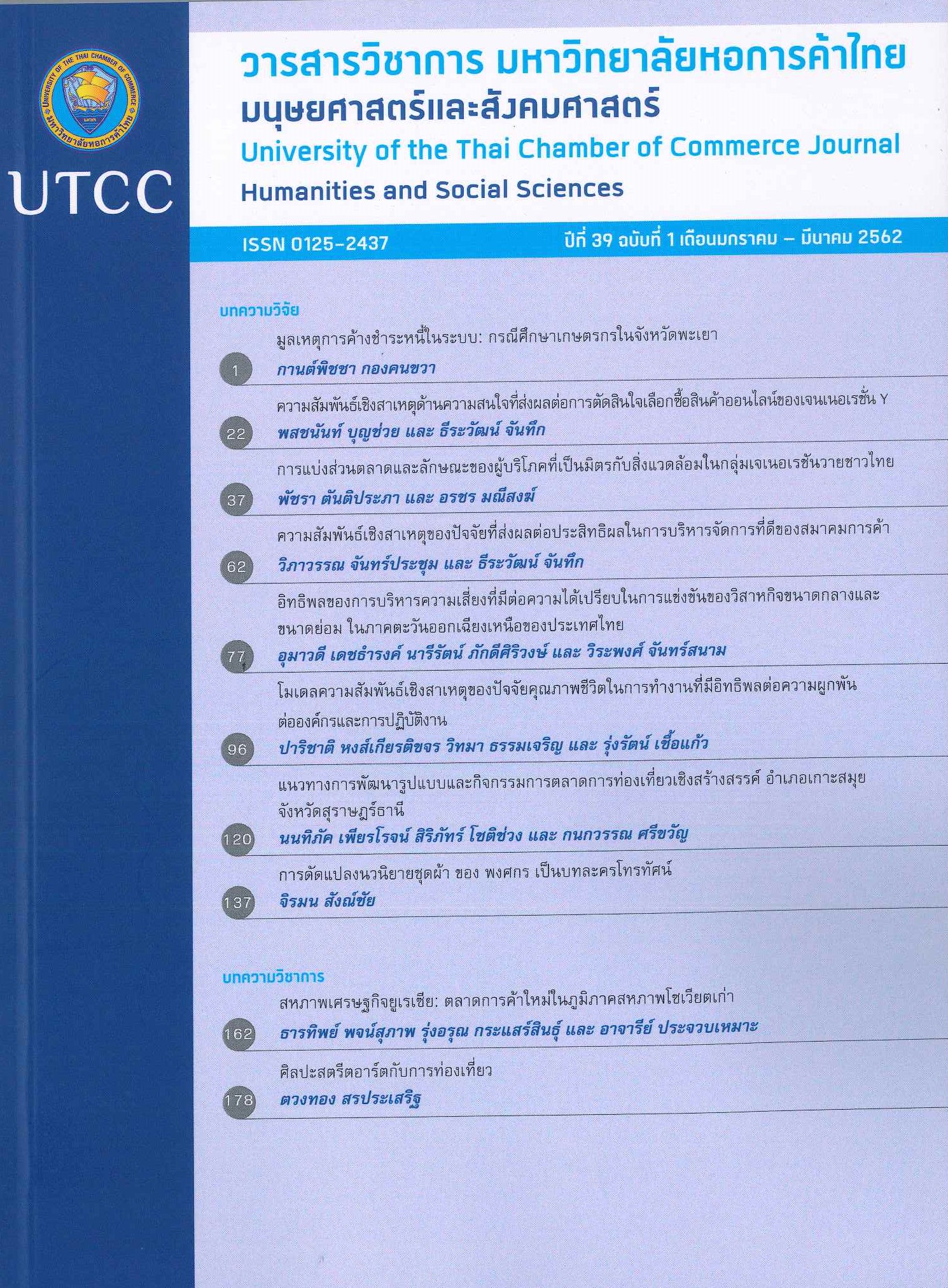Segmenting and Profiling of Green-consumers in Thai Generation-Y
Main Article Content
Abstract
This study aims at segmenting and profiling green consumers in Thai generation Y (those who were born during 1977-1994). Data were collected from 435 generation Y consumers in four regions of Thailand: North, Central, North-East, and South, by quota sampling method. Data obtained were analyzed by factor analysis to reduce variables and by cluster analysis to divide consumers into groups. Five emerged groups consist of cautious environmental product shoppers, environmental conservatism, environmental unconcern, environmental activists and undefined group. Main characteristics of cautious environmental product shoppers are having
knowledge of environmental problems, being skeptical about environmental claims, and having behavior of considering to buy environmental friendly products. Main characteristics of environmental conservatism group are environmental concern, recycling, resource saving, and willing to pay more for environmental reasons. The main characteristic of unconcern group is having low perceived consumer effectiveness to create an environmental impact. Main characteristics of activists are
having environmentally friendly buying behavior and playing role in environmental rally. The undefined group has no prominent characteristic. The consumers in these 5 groups were significantly different in demographic characteristics; i.e. residential regions (χ2= 81.378, p < 0.001), highesteducation level (χ2= 29.242, p < 0.001), occupation (χ2= 35.251, p = 0.004), average monthlyincome (χ2= 19.880, p = 0.011), and attitude/behavior as green consumers (χ2= 51.519, p < 0.001).
Article Details
ลิขสิทธิ์ของบทความ
ผลงานที่ได้รับการตีพิมพ์ถือเป็นลิขสิทธิ์ของมหาวิทยาลัยหอการค้าไทย ห้ามมิให้นำเนื้อหา ทัศนะ หรือข้อคิดเห็นใด ๆ ของผลงานไปทำซ้ำ ดัดแปลง หรือเผยแพร่ ไม่ว่าทั้งหมดหรือบางส่วนโดยไม่ได้รับอนุญาตเป็นลายลักษณ์อักษรจากมหาวิทยาลัยหอการค้าไทยก่อน
References
รัชฎา อสิสนธิสกุล, และอ้อยอุมา รุ่งเรือง. (ม.ป.ป.). เจนเนอเรชั่นวาย...ทำไมน่าสนใจ? สืบค้นเมื่อ 8 สิงหาคม 2560,จากhttps://www.bizexcenter.com/บทความทางธุรกิจ/เจนเนอเรชั่นวาย-การทำตลาดกับแต่ละเจนเนอเรชั่น.html
Armstrong, G. and Kotler, P. (2015). Marketing An Introduction. (12th ed.).Essex: PearsonEducation Limited.
Awad, T. A. (2011). Environmental segmentation alternatives: Buyers’ profiles and implications.Journal of Islamic Marketing, 2(1), 55-73.
Bolton, R. N., Parasuraman, A., Hoefnagels, A., Migchels, N., Kabadayi, S., Gruber, T., Solnet, D. (2013). Understanding generation y and their use of social media: a review and research agenda. Journal of Service Management, 24(3), 245-267.
Chan, K. (1999). Market segmentation of green consumers in Hong Kong. Journal of International Consumer Marketing, 12(2), 7-24.
Chan, R. Y. K. (2001). Determinants of Chinese consumers‘green purchase behavior. Psychology & Marketing, 18(4), 389-413.
Finisterra do Paco, A. M., &Raposo, M. L. B. (2008). Determining the characteristics to profile the green consumer: an exploratory approach. International Review Public Nonprofit
Marketing, 5, 129-140.
Finisteerra do Paco, A. M., & Raposo, M. L. B. (2010). Green consumer market segmentation: Empirical findings from Portugal. International Journal of Consumer Studies, 34, 429-436.
Fraj,E., & Martinez,E. (2006).Environmental valuesandlifestylesasdeterminingfactorsofecological consumer behavior: An empirical analysis. Journal of Consumer Marketing, 23(3), 133-144.
Ghosh, M. (2010). Green marketing-A changing concept in changing time. BVIMR Management Edge, 4(1), 82-92.
Gilg, A., Barr, S., & Ford, N. (2005). Green consumption or sustainable lifestyles? Identifying the sustainable consumer. Futures, 37, 481-504.
Goforth, C. (2015). Using and interpreting Cronbach’s Alpha. Retrieved February 17, 2018, from https://data.library.virginia.edu/using-and-interpreting-cronbachs-alpha
Goldsmith, E. B., & Goldsmith, R. E. (2011). Social influence and sustainability in households. International Journal of Consumer Studies, 35, 117-121.
Gupta, S., & Ogden, D. T. (2009). To buy or not to buy? A social dilemma perspective on green buying. Journal of Consumer Marketing, 26(6), 376-391.
Hawkins, D. I., & Mothersbaugh, D. L. (2013). Consumer behavior: Building marketing strategy (13th ed.). New York: McGraw-Hill/Irwin.
Hill, J., & Lee, H. H. (2012). Young generation Y consumers’ perceptions of sustainability in the apparel industry. Journal of Fashion Marketing and Management, 16(4), 477-491.
Jain, S. K., & Gurmeet, K. (2006). Role of socio-demographics in segmenting and profiling green consumers: An exploratory study of consumers in India. Journal of International
Consumer Marketing, 18(3), 107-146.
Kanchanapibul, M., Lacka, E., Wang, X., & Chan, H. K. (2014). An empirical investigation of green purchase behavior among the young generation. Journal of Cleaner Production, 66, 528-536.
Marshall, G. W., & Johnston, M. W. (2010). Marketing management (International ed.). New York: McGraw-Hill/Irwin.
Park, J. S., & Lee, J. (2014). Segmenting green consumers in the United States: Implications forgreenmarketing. Journal of Promotion Management, 20(5), 571-589.
Rahbar, E., & Abdul Wahid, N. (2010), The Malaysian consumer and the environment: Purchase behavior.Global Business & Management Research, 2(4), 323-336.
Rogers, G. (2013, February 4). The rise of Generation Y in the sustainable marketplace [Weblog message].Retrieve from https://www.theguardian.com/sustainable-business/
blog/rise-generation-y-sustainable-marketplace#comments
Schiffman, L. G., & Wisenblit, J. (2015). Consumer behavior (11th global ed.). Essex, England:Pearson Education.


